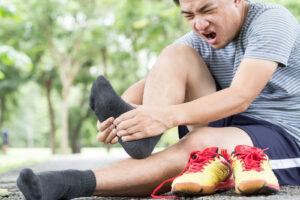Pathophysiology
Osteoarthritis (OA) is characterised by the breakdown of cartilage and underlying bone within the joint.
Other structures also are affected by OA, with inflammation of the synovium and narrowing of the joint space commonly seen. The ligaments surrounding the joint may also be effected becoming thickened and fibrotic.
Although there is not one distinct causal factor for OA it can be described as being caused by excessive mechanical stress applied in the context of systemic susceptibility (Hunter & Eckstein, 2009).
Effect of OA on Foot Health
OA can affect foot health and mobility in a variety of ways depending on specific joints within the foot affected and the level of degeneration in particular joints. Despite this the progression of OA has predictable effects on foot health:
Pain – which becomes worse with activity, and is particularly bad after a period of inactivity.
Morning stiffness - Stiffness and difficulty moving the affected joints for approximately 30 minutes in the morning.
Joint Locking and instability – Patients with OA will often experience “joint locking” where the joint will become “stuck” during the normal range of motion or a feeling of instability especially during weightbearing activities (Sinusas, 2012). Crepitus an audible creaking or clicking within the joint as it moves can also be apparent.
These generalised symptoms of OA when found in the foot can result in a difficulty or inability to bear weight, difficulty and pain during ambulation and ultimately decreased activity levels. Those with severe OA can often have trouble during activities of daily living.
Podiatric Management
Podiatric management of OA aims to decrease pain and improve functioning in the foot.
Orthotics – Current evidence has suggested that orthotic devices can provide some benefit to patients with OA. Orthotics are suggested to change gait patterns, muscle activation and ultimately reduce joint loads in those with OA. (Riskowski,Dufour & Hanna, 2011). In addition orthotics through the use of soft and supportive materials can provide cushioning and shock absorption to the feet. Patients in study by Ibuki et al (2010) reported decreased pain levels, increased activity levels and improved walking ability when provided with orthotic devices for midfoot OA.
Footwear – Studies have shown that orthopedic footwear can decrease pain, increase physical functioning and increase gait velocity in those with OA. In addition footwear can decrease ground forces and provide support to unstable joints (Fransen & Edmonds, 1997).
Exercise – Low impact therapeutic exercise routines which place an emphasis on strengthening and stretching the muscles in the OA affected area of been shown to be beneficial for patients. Patients who begin and maintain exercise regimens have been shown to have a decrease in pain levels and increase in muscle function.
If this sounds like you or someone you know please don’t hesitate to contact the clinic on 9434 4422 or book an appointment online at anytime.
We look forward to getting you back to doing the things you love sooner!
Written by Nick Walters – Podiatrist at the Diamond Valley Foot & Ankle Clinic
Articles used
Fransen, M., & Edmonds, J. (1997). Off-the-shelf orthopedic footwear for people with rheumatoid arthritis. Arthritis & Rheumatism, 10(4), 250-256. doi: 10.1002/art.1790100406
Hunter, D. J., & Eckstein, F. (2009). Exercise and osteoarthritis. Journal of Anatomy
, 214
(2), 197–207. http://doi.org/10.1111/j.1469-7580.2008.01013.x
Ibuki, A., Cornoiu, A., Clarke, A., Unglik, R., & Beischer, A. (2010). The effect of orthotic treatment on midfoot osteoarthritis assessed using specifically designed patient evaluation questionnaires. Prosthet Orthot Int, 34(4), 461-471. doi: 10.3109/03093646.2010.503672
Rabago, D., Slattengren, A., & Zgierska, A. (2010). Prolotherapy in Primary Care Practice. Primary Care
, 37
(1), 65–80. http://doi.org/10.1016/j.pop.2009.09.013
Riskowski, J., Dufour, A. B., & Hannan, M. T. (2011). Arthritis, Foot Pain & Shoe Wear: Current Musculoskeletal Research on Feet. Current Opinion in Rheumatology
, 23
(2), 148–155. http://doi.org/10.1097/BOR.0b013e3283422cf5
Sinusas, K. (2012). Osteoarthritis: diagnosis and treatment. Am Fam Physician, 85(1), 49-56.
Valderrabano, V., & Steiger, C. (2011). Treatment and Prevention of Osteoarthritis through Exercise and Sports. Journal of Aging Research
, 2011
, 374653. http://doi.org/10.4061/2011/374653
Sinusas, K. (2012). Osteoarthritis: diagnosis and treatment. Am Fam Physician, 85(1), 49-56.
Hunter, D. J., & Eckstein, F. (2009). Exercise and osteoarthritis. Journal of Anatomy
, 214
(2), 197–207. http://doi.org/10.1111/j.1469-7580.2008.01013.x
